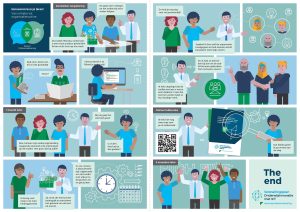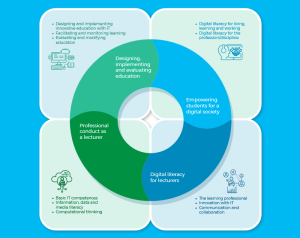
Implementing educational innovations in higher education: from initiation to organizational routine
Educational innovation using ICT has been a priority in higher education for years, due to its impact on the quality


Month of AI
With Artificial Intelligence (AI), we help students’ learning by: Providing my students with automatic feedback on submitted assignments; automatically classifying students into a group that needs extra support and a group that can proceed independently; automatically adapting assignments to the needs of the individual student. This sounds fantastic! But at the same time, there is a little voice in my head: The AI application does not know my students as well as I do. The AI application might say that student X can continue on his own, but I know that this student needs extra help; the AI application might make mistakes that make the assignments less relevant to the students’ needs.
I can’t turn off that little voice in my head, and I don’t want to. I want to learn more about the application of AI in education. I am convinced that the combination of high tech and human touch is essential. As a lecturer, I have a lot of knowledge about my subject, didactics and I find the relationship between me and my students essential. AI cannot replace this. AI can, however, help me automate certain tasks. For example, I now spend a lot of time extracting and combining data from our LMS (in my case Canvas), the data from the polls and quizzes I conducted with my students during the lectures and the course evaluations as completed by students. And of course, grading assignments also takes up a lot of my time. Based on all this data, I determine what went well and what didn’t, how I can help my students and what adjustments I want to make in my teaching. AI can help me with this in the future, because AI is very good at analysing data, detecting patterns, classifying and diagnosing.
However, a number of things are essential here. First of all, it is important that I, together with my colleagues, think carefully about the goals we pursue for our education and which data and AI applications could help us to achieve them. Of course, ethical and privacy considerations also play a role here. Secondly, when we start working with an AI application, we have to delve into the so-called black box of this AI application. This is about what data is included in the application. Are there no errors, such as missing data, student numbers that are taken as numbers, or dots and commas that are mixed up? Here, the well-known principle of “garbage in – garbage out” applies. We also need to know something about how the application diagnoses and arrives at possible decisions. This is also important, for example, to avoid possible bias. Suppose the AI application comes up with the advice that only male students need extra support. Then it is good to check if gender is not overemphasised in the algorithm that the application uses.
Whether the decision that the AI application comes up with is executed by the AI, the student or the lecturer, I as a lecturer have an important task in monitoring this. For example, does the AI application work the way we thought it would? Are students satisfied with the feedback they automatically receive? Do the assignments selected by the AI suit the learning needs of the students? Learning more about AI (and thus professionalising) is crucial. I can use it to improve my teaching. In addition, I can use it to better prepare my students for the labour market. This is because AI plays an increasingly important role here. It seems to me a great opportunity to learn more about AI in education, together with my colleagues and students. What should we keep in our own hands and what can we automate and leave to the AI application, in other words: How do we achieve the ultimate blend of artificial and human intelligence?
June has been declared the month of Artificial Intelligence in education. Dive into the world of AI with various webinars, hackatons and lectures. Also read the other blogs of our members of the Acceleration Plan or participate in the activitiesthat are organised.
Share this page

Educational innovation using ICT has been a priority in higher education for years, due to its impact on the quality

Blended learning. A concept that is high on the agenda in education land. Are you working on blended learning within

Making optimal use of the possibilities of IT in higher education requires new knowledge and skills from lecturers. As a

Do you want to know which digital competences of lecturers are relevant for educational innovation with IT? Then get to